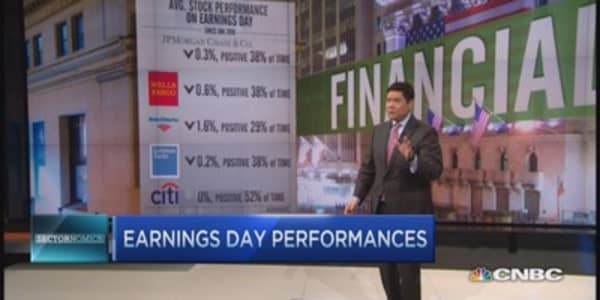With America's quantitative easing program coming to an end, investors around the globe are now wondering when interest rates will rise. We are already beginning to see increased volatility and market jitters with the S&P 500 down about 3 percent last week.
However, there is one sector that's likely thinking about this more than most: the U.S. life insurance industry.
The sector has struggled mightily over the last seven years, in large part due to falling long-term interest rates. The S&P 500 insurance sub-index, which includes a dozen life insurance companies and nine property-and-casualty operations, started falling in October 2007, a full year before the financial crisis.
Between that month and March 6, 2009, when the S&P 500 hit rock bottom, the index fell by about 70 percent. Over the same time period, the 10-year treasury rate fell by 22 percent, while the federal funds rate dropped by about 96 percent.
It didn't help that in 2008, American International Group, one of the world's largest insurance firms, nearly failed and had to have the Federal government bail it out. While the company's problems weren't related to insurance products—it had to do with collateralized debt obligations—its troubles did scare investors off the overall financial sector.
The insurance sub-index has climbed nearly 257 percent since the market's trough—better than the S&P 500's 159 percent gain—but many life insurers still look attractive compared to the overall market, said Charles DyReyes, a senior research analyst with Brandywine Global, an investment firm that manages $58 billion in assets.
The group is trading at about 10 times earnings, much lower than the overall benchmark's 17 times, and while share prices overall have risen since the recession, many large-cap names have barely budged over the last three years. MetLife, for instance, is up just 24 percent since January 2011.
"A lot of stocks haven't done anything," said DyReyes. "We're going on four years of nothing happening—no stock price movement. That's unprecedented. The rest of the financials have rebounded, but MetLife and other insurers haven't done anything at all."
There's no question that these stocks will climb when rates rise. We saw it happen in 2013. Between June and December of last year, when the 10-year treasury yield went from 2 percent to 3 percent, the insurance sub-index climbed by 17 percent.
Interest rates, though, are volatile at the moment. In January the 10-year yield fell to 2.6 percent, which caused the sub-index to drop by about 9 percent.
Read MoreTime to claim overlooked insurance stock profits
More rate certainty would help these stocks, but it's still not clear when overnight and long-term rates will see a more permanent move. "So far, the market is pricing almost zero, probably of rising happening in this group," said DyReyes.
Rate-sensitive sector
Many sectors are impacted by the rise and fall of rates, but life insurance companies are especially sensitive to the ups and downs, said Vincent Lui, an equity analyst with Morningstar. That's because of how these companies invest people's money. When someone buys a policy, those dollars, along with everyone else's payments, gets invested in long-term fixed-income products.
Insurance companies make a profit off the difference between what it owes the policyholder versus what it can make in the bond market. When rates are high, it makes more money off that spread. When it falls, businesses make less.
Before the crisis, that spread was about 3 percent, said Lui. It's now between 1 percent and 1.5 percent. That might seem like a small drop, but multiply that by millions of policies and it adds up. "It really has a profound effect on their investments," he said.
Time for a turnaround
The recession impacted the sector in two big ways: Falling rates reduced profits, but it also wreaked havoc on its lineup of guaranteed products.
Many companies offered variable annuities before the recession, which guaranteed a specific return after a certain date. The combination of falling interest rates and plummeting equity markets, though, made it difficult for companies to meet those guarantees. While companies ultimately made their payments, many, such as MetLife and Prudential Financial, ended up pairing down their variable annuity business, said DyReyes. Others, like ING U.S., scrapped their variable annuity business altogether.
Losing that business was a big blow to many companies, but it also helped to lower the sector's overall risk—and it made company executives rethink how they do business.
Read MoreQuiz: How much do you know about dividends?
"Everyone was gunning for market share before the recession," said DyReyes. "People were pricing products very low, and returns were so low that people felt significant pressure to grow their share. "That discounting has stopped, and the focus now is on maintaining the business they've got."
These days, companies are more focused on selling "plain vanilla" products—the traditional life insurance policies most people buy, said Lui. Some are also entering the asset-management space, which isn't as capital intensive as other lines of business but can bring in a lot of money.
Companies, such as AIG, have also been using big data analytics to better assess risk, and many, like MetLife, have moved into more global markets, said Gloria Vogel, a senior vice president and analyst at Drexel Hamilton.
Despite the problems the sector has faced, many of these companies remained profitable after the recession, and they're still making money today. Earnings are mostly growing in line with GDP, and some companies, including MetLife, Prudential Financial and Aflac, are seeing double-digit returns on equity, she said. Things should only get better from here.
Read MoreFinancials and the Fed
"Most insurance stocks are good long-term-value plays, trading at reasonable valuation levels," she added. "Cash flow is good, dividends are growing, and profits should improve with higher interest rates."
Saying that, there are two things that could affect the industry's outlook. The first is if interest rates fall. While most people are expecting rates to rise next year—if the economy falters again or if the Federal Reserve doesn't think the country is ready for a rate increase—then yields could drop. Companies would then make less than they do now.
Regulation could also impact these businesses, said Lui. While the industry hasn't seen as much regulation as the banking sector has, new rules could come into play that impact how much capital a company needs to have on its balance sheets. If the regulation is too harsh, then these businesses could suffer, he said.
Buy diversified companies
Still, the sector overall is in better shape than it was six years ago, but some companies have done more to lower their risk profile than others.
MetLife, for instance, reduced it's variable annuity offerings, sold off a large part of its illiquid real estate investments and got rid of its retail banking division, said Lui. It also has a diversified revenue base, with money coming in not only from their life division but from property and casualty as well.
A diverse source of revenue is key these days, said Lui. If the product offering is too narrow or if it's making money off of one line of business, then it could run into trouble during another downturn. "If the macro environment changes, then one side of the business can still generate a good return," he said.
Companies with emerging market exposure are also attractive, said Drexel Hamilton's Vogel. The idea here is the same as it is with most other sectors—the more people move into the middle class, the more they want U.S.-style goods. That includes life insurance.
Read MoreInsurance stocks for sale
MetLife, one of DeReyes' favorite life insurers, has said that it wants emerging markets to account for at least 20 percent of operating earnings by 2016, up from 14 percent in 2012.
Also pay attention to what types of fixed-income instruments these companies are using, said DyReyes. The companies that own more short-term investment-grade issues will see the best earnings bounce when rates rise, as they'll be able to start rolling over their bonds into higher-yielding products immediately, he said.
Firms that own a lot of lower-quality credit or long-term bonds won't see the same benefit. "If you see a company with 50 percent AAA and 50 percent high yield, then I'd definitely worry," he said.
You can find out where companies invest by looking at their 10-K filing, said Lui. It usually shows a distribution of the credit quality of a company's bond portfolio. Unfortunately, not all companies break down their portfolio by duration rates, meaning that in some cases you won't be able to find out how much money is invested in long-term vs. short-term bonds.
Although life insurers have found ways to grow earnings independent of rate movements, these stocks will certainly climb higher once it becomes clear when interest rates will rise.
Investors may have to be patient, but it's better to buy in too early than too late. DeReyes thinks these stocks could jump by 50 percent over the next two or three years.
"If investors start to think that rates will move, then the stocks will increase," he said. "Until then, collect the dividend. I'll take sitting on dead money for a year to make a 50 percent upside. I don't see how we lose."





